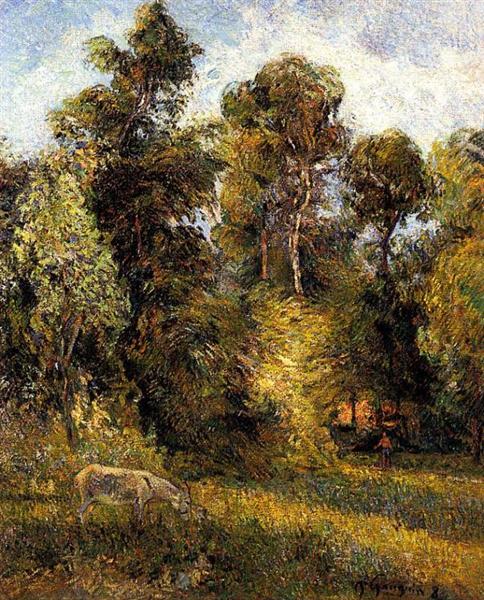Description
A central figure in Post-Impressionism, Paul Gauguin is known for his innovative approach to color and form, aspects that are most clearly evident in his work The Edge of the Forest (1885). Illustrating the artist's fascination with nature and his desire to go beyond the simple visual record, this painting is set at a crucial moment in his artistic evolution, marking a transition towards a more symbolic and less naturalistic use of color.
The composition of “The Edge of the Forest” reveals Gauguin’s skill in working with space and light. Showing the convergence of a forest edge with an open landscape, the canvas evokes a sense of mystery and depth. The robust and richly textured tree trunks are presented in an earthy color scheme that contrasts with the vibrant green of the surrounding vegetation. This use of color not only defines the atmosphere of the work, but also enhances the emotional message emanated by the natural elements. The fusion of greens, ochres and browns is transformed into a visual language that invites the viewer to contemplate nature in its purest and most elemental state.
One of the most intriguing elements of the painting is the absence of human figures, an element that, while common in some of Gauguin's works, inspires questions about the relationship between man and his natural environment. In "The Edge of the Forest," the landscape becomes a singular protagonist, suggesting a narrative that alludes to the desire for connection with nature. Without the distractions that human figures can present, the viewer is encouraged to delve into the feelings that the environment evokes. This approach seems to anticipate Gauguin's later work in Tahiti, where his relationship with the landscape and its symbolism would become even more prominent.
Gauguin is also noted for his ability to synthesize diverse influences in his work. “The Edge of the Forest” displays impressionistic traits in its capture of light and color, while at the same time beginning to lean toward deeper symbolism. This intersection between visual representation and emotionality is a hallmark of his career, and it comes through clearly in this work. The way the colors are applied with a thick, expressive brush, and how the tones are juxtaposed, emphasizes not only the physicality of the landscape, but also its emotional resonance.
Historically, The Edge of the Forest is set in a period when Gauguin was beginning to distance himself from the professional technique he had learned, seeking a more personal and essential mode of expression. The work can be considered a precursor to his bolder experiments in the future, where shapes and colours are freed from the conventions of realism. His legacy, marked by a path towards symbolic abstraction, leaves an indelible mark on modern art.
The study of “The Edge of the Forest” not only offers a glimpse into Gauguin’s technical mastery, but also invites reflection on the relationship between humanity and nature, a theme deeply rooted in his work. By creating spaces of introspection and contemplation, Gauguin reminds us that art has the power to transform our perception of the world, leading us to explore what lies beyond the visible. At its core, this painting is a testament to his constant search for beauty and truth, resonating with the echo of a landscape that, although depicted, never ceases to be a mystery to be unraveled.
KUADROS ©, a famous painting on your wall.
Hand-made oil painting reproductions, with the quality of professional artists and the distinctive seal of KUADROS ©.
Painting reproduction service with satisfaction guarantee. If you are not completely satisfied with the replica of your painting, we will refund 100% of your money.

